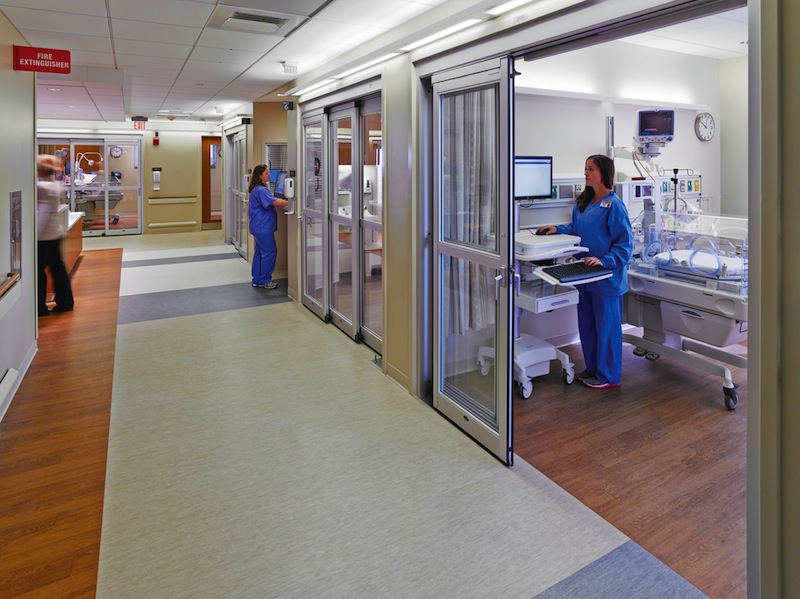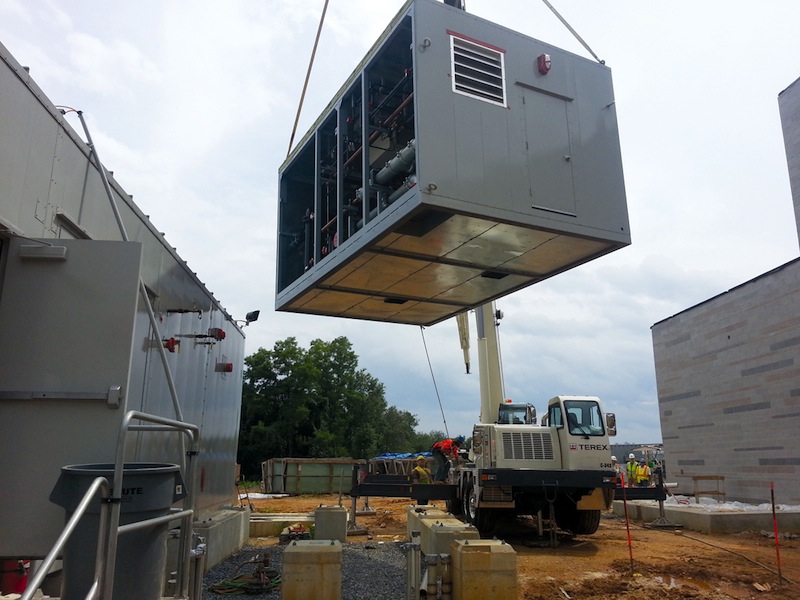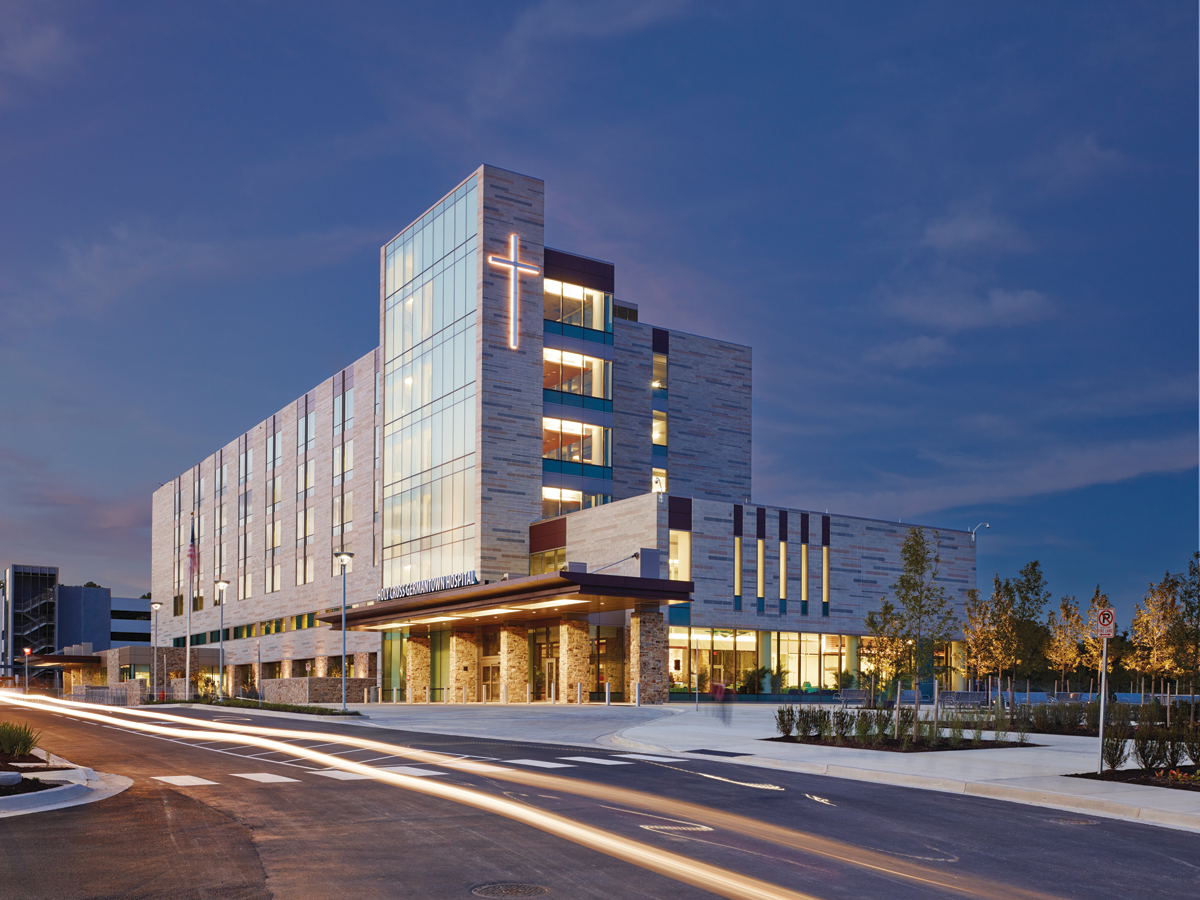Holy Cross Health, a Catholic healthcare system in Maryland, opened its new 237,000-sf hospital in Germantown last October 1, thanks to a Building Team—led by SmithGroupJJR (architect), CBRE Healthcare (PM), and Whiting-Turner (GC/CM)—that simply wouldn’t give up, despite the obstacles it faced.
The 93-bed Holy Cross Germantown Hospital is the first new hospital to be built in Maryland in 25 years, the first new hospital in Montgomery County in 35 years, and the first in the U.S. to be built on a community college campus. Yet it was threatened from the very beginning.
PROJECT SUMMARY
GOLD AWARD
Holy Cross Germantown Hospital
Germantown, Md.BUILDING TEAM
Submitting firm: SmithGroupJJR (architect)
Owner: Holy Cross Health
Project manager: CBRE Healthcare
SE: McMullan & Associates, Inc.
MEP: Syska Hennessy Group
CE/Landscaping: Macris, Hendricks and Glasscock
GC/CM: Whiting-TurnerGENERAL INFORMATION
Project size: 237,000 gsf (93 beds)
Construction cost: $110 million; $200 million total project budget
Construction period: June 2012 to September 2014
Delivery method: CM at risk
Seven years ago, Holy Cross Health President Kevin Sexton asked SmithGroupJJR to explore a partnership with Montgomery College Germantown for a new hospital on its campus. The master plan had to go through two cycles to get the go-ahead from county commissioners; then the Maryland–National Capital Park and Planning Commission had to give its OK. By October 2008, Sexton had funding in the bag from Holy Cross’s parent, Trinity Health, and was ready to file a certificate of need. That’s when all hell broke loose.
First, a rival hospital system contested Holy Cross’s CON. Worse still, the recession forced Trinity to pull the plug on all construction in its system.
On its own dime, SmithGroupJJR convened a two-day “workshop” in San Francisco with Whiting-Turner and others to explore ways to build a more cost-effective “hypothetical” 100-bed hospital. They took their recommendations back to Sexton, and within a year, he had the green light from Trinity. Holy Cross Germantown had new life.
just for fun, let’s add a few MORE HURDLES
In the interim, Trinity had issued new mandatory design criteria: projects were to be held to no more than $750,000 and 2,100 sf per bed. The state also tightened up its CON requirements and gave the Building Team only 90 days to develop a CON package that would meet the new criteria.
Using ideas derived from the workshop, the team came up with a three-point plan: 1) split the facility into two components—a patient tower with diagnostic and treatment facilities, and a support wing; 2) specify discrete structural, mechanical, and utility systems for each component, which would reduce costs, simplify MEP distribution, and yield more total square footage; and 3) build a prefabricated modular central utility plant that would be exempt from the CON-mandated square footage, thus yielding more clinical space.
This design scheme resulted in 30–40% savings in the sf/bed ratio. In May 2012, the Maryland Health Care Commission unanimously approved the CON. Holy Cross Germantown breathed yet another life.
Holy Cross Health’s mission called for prudence, not opulence. To fulfill that goal, the Building Team used full-scale, furnished mockups for labor/delivery, med/surg, and ICU patient rooms to get feedback from clinicians. The resulting design saved costs by reducing the amount of casework along footwalls. In reviewing bathroom mockups, Whiting-Turner suggested constructing the concrete slabs with a three-foot-radius swale sloped to the shower drain rather than a rectangular depression. This saved $125,000.
Midway through construction, a new head of surgery asked the team to consider a same-handed approach to the surgical suite layout, rather than the customary mirrored floor plan. This complicated the above-ceiling coordination for medical gases, supply air, light booms, and supports, especially since the plumbing and electrical sleeves were already in place. The team constructed virtual mockups to coordinate the work, which was completed with minimal disruption.
Note: SmithGroupJJR’s Bill Kline, a member of the awards jury, recused himself from this project.
 Maternity services include labor and delivery rooms, caesarean surgical suites, private postpartum rooms, and an eight-bed neonatal care unit.
Maternity services include labor and delivery rooms, caesarean surgical suites, private postpartum rooms, and an eight-bed neonatal care unit.
 A prefabricated module is lifted into place for the central utility plant. Prefabrication enabled the components to be shipped in large sections like this and assembled ready for operation in less than three weeks.
A prefabricated module is lifted into place for the central utility plant. Prefabrication enabled the components to be shipped in large sections like this and assembled ready for operation in less than three weeks.
Related Stories
Cultural Facilities | Mar 27, 2024
Kansas City’s new Sobela Ocean Aquarium home to nearly 8,000 animals in 34 habitats
Kansas City’s new Sobela Ocean Aquarium is a world-class facility home to nearly 8,000 animals in 34 habitats ranging from small tanks to a giant 400,000-gallon shark tank.
Market Data | Mar 26, 2024
Architecture firm billings see modest easing in February
Architecture firm billings continued to decline in February, with an AIA/Deltek Architecture Billings Index (ABI) score of 49.5 for the month. However, February’s score marks the most modest easing in billings since July 2023 and suggests that the recent slowdown may be receding.
Cultural Facilities | Mar 26, 2024
Renovation restores century-old Brooklyn Paramount Theater to its original use
The renovation of the iconic Brooklyn Paramount Theater restored the building to its original purpose as a movie theater and music performance venue. Long Island University had acquired the venue in the 1960s and repurposed it as the school’s basketball court.
Adaptive Reuse | Mar 26, 2024
Adaptive Reuse Scorecard released to help developers assess project viability
Lamar Johnson Collaborative announced the debut of the firm’s Adaptive Reuse Scorecard, a proprietary methodology to quickly analyze the viability of converting buildings to other uses.
Security and Life Safety | Mar 26, 2024
Safeguarding our schools: Strategies to protect students and keep campuses safe
HMC Architects' PreK-12 Principal in Charge, Sherry Sajadpour, shares insights from school security experts and advisors on PreK-12 design strategies.
Green | Mar 25, 2024
Zero-carbon multifamily development designed for transactive energy
Living EmPower House, which is set to be the first zero-carbon, replicable, and equitable multifamily development designed for transactive energy, recently was awarded a $9 million Next EPIC Grant Construction Loan from the State of California.
Museums | Mar 25, 2024
Chrysler Museum of Art’s newly expanded Perry Glass Studio will display the art of glassmaking
In Norfolk, Va., the Chrysler Museum of Art’s Perry Glass Studio, an educational facility for glassmaking, will open a new addition in May. That will be followed by a renovation of the existing building scheduled for completion in December.
Sustainability | Mar 21, 2024
World’s first TRUE-certified building project completed in California
GENESIS Marina, an expansive laboratory and office campus in Brisbane, Calif., is the world’s first Total Resource Use and Efficiency (TRUE)-certified construction endeavor. The certification recognizes projects that achieve outstanding levels of resource efficiency through waste reduction, reuse, and recycling practices.
Office Buildings | Mar 21, 2024
Corporate carbon reduction pledges will have big impact on office market
Corporate carbon reduction commitments will have a significant impact on office leasing over the next few years. Businesses that have pledged to reduce their organization’s impact on climate change must ensure their next lease allows them to show material progress on their goals, according to a report by JLL.

















